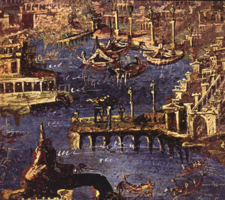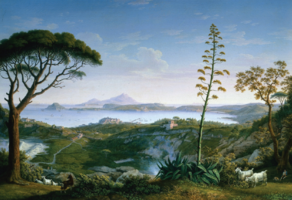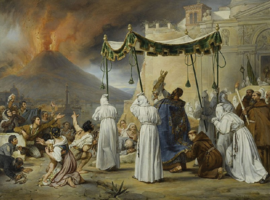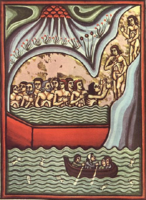Case Study A.2: Pozzuoli-Solfatara-Astroni
>>>back to working groups overview
Rationale
The visual key of the area under study can be represented by the Carte del golfe di Pouzzoles di Jean-Claude Richard de Saint-Non, Abbé de Saint-Non. He was engraver, designer, humanist, archaeologist, patron and French traveler. The first key word of our study area is heritage: in fact the territory of Pozzuoli is extremely rich as regards the historical and cultural heritage, as we will see in one of the following slides of this work. The second key word is resources: the resources of the territory and the sea. The territory of Pozzuoli is geologically and morphologically very varied and, therefore, very interesting. Its weaknesses have always represented also a resource and, if properly exploited, can represent great potential. Even the sea represents a great resource, just think of the fact that Pozzuoli was an international trade center of great importance in antiquity. The Gulf of Pozzuoli has a strategic role as it can interconnect the Phlegraean area with the rest of the city of Naples and with the Phlegraean islands. The third key word is energy. What appears evident when studying this area is its latent energy; an energy that, if channeled into a precise program of interventions, can be transformed into a strength and an opportunity for development. Our hypothesis for this area is the enhancement of local identities and their transformation into development opportunities, above all tourism.
Location and scope
You can edit this map with the map editor
A Landscape System Analysis
A.1 Landscape layers and their system context
Geomorphology, landscape units and coastal typology
- Description of evolution, status quo and driving forces, is the coastal typology changing? Why is that? (approx 200 signs)
- add 1-2 graphical representations to the image gallery, you can add more if you like
- Yourcase landscapeunits1.jpg
add a caption
- Yourcase landscapeunits2.jpg
add a caption
Land use
- settlements, infrastructure, agriculture, resource extraction, natural areas, energy production...
- description of evolution, status quo and driving forces, is the land use likely to change? Why is that? (approx 200 signs)
- add 1-2 graphical representations to the image gallery, you can add more if you like
- Yourcase landuse1.jpg
add a caption
- Yourcase landscapeunits2.jpg
add a caption
- Yourcase landscapeunit3.jpg
add a caption
Green/blue infrastructure
- When considering the case study, the green areas are well represented by the Mediterranean flora and rich fauna. The Vesuvius National Park includes Mount Somma (from which the volcanic cone of Mount Vesuvius formed) and contains two Sites of community importance, on which a Special Protection Area overlaps. The Phlegraean Fields is a large volcanic area with 24 craters and volcanic edifices. Solfatara is the most interesting volcano formed from 40 ancient volcanoes.Is an active volcanic crater with effusive gaseous manifestations, which emit sulfur through mud small volcanoes ("solfo" is Italian for "sulfur"). Inland, the "blue" is present in the Astroni Natural Craters Reserve, which is also a Special Protection Area surrounded by forest and presents three lakes: Lago Grande, Cofaniello Piccolo and Cofaniello Grande, and here we find typical vegetation for wetlands. The blue represented by The Gaiola Underwater Park is a marine area of 42 hectares wich include the Naples gulf with flora and fauna typical of the Mediterranean Sea. Thus, the study area presents a strong touristic and economic development potential.
- You find my background material on green infrastructure in our reading list
- add 1-2 graphical representations to the image gallery, you can add more if you like
- Your case green blue infrastructure1.jpg
add a caption
- Your case green blue infrastructure2.jpg
add a caption
Actors and stakeholders
The study area is under the administration of the municipality of Pozzuoli. As in every region we find the municipal urban plan (PUC), it is a management tool of the Italian municipal territory, composed of cartographic and normative documents (urban legislation) that regulate the management of urban and territorial transformation activities of the pertinent municipality. There are many institutions that operate in the area. The authorities of the basin work for the soil, lakes and sea shores. Civil Protection for the countless seismic activities, and the superintendence of cultural heritage is concerned with bearing all the assets that belongs to our history and to the heritage of humanity."
- Draw a stakeholder and/or power map: Who is affected highly but with low power? Who has high power but is not affected?
- Your case your powermap.jpg
- === Sacred spaces and heritage ===
- "Many puteolan place and elements hold cultural value and symbolic meaning.
- The Monument to the Fallen on Work was created in 1980. On a stone pedestal, there is a sculpture in iron sheet. It recall the fallen in the primary, secondary and tertiary sector."
- === Visual appearance and landscape narrative ===
- The study area was not only demonstrated by drawing, but by literature such as, De Balneis Puteolanis, a poem desrcibing various thermal baths in Campi Flegrei.
- Furthermore it has been mentioned its history that Sulla, the Roman Dictator owned a country villa in the region, the apostle Paul landed here on his way to Rome...
- From all these different types of documentations since the time of Roman Empire, we can tell that this charismatic and inspirational piece of landscape is important in both natural and anthropogenic histories of the region.
A.2 Summary of you landscape system analysis and your development Targets
- You can summarize your findings with an DPSI(R) Model or a Spider Diagram
- Link back to the Sustainable Development Goals: Which goals are at risk?
- What is your hypothesis for this landscape?
- Visualise your hypothesis with one graphic/pict
- Are there any existing initiatives taking action in this landscape? Do you have a critical perspective on that?
- Add text and visuals
- Your case your spider diagram or dpsir model.jpg
explain your analysis briefly in the caption
- Your case your hypothesis visual.jpg
explain your hypthesis briefly in the caption
A.3 Theory reflection
- Reflect on at least three international policy documents in relation to their local landscape case
- choose one international, one European and one national document
- You can choose references from our reading list
- Scope: 250 words
A.4 References
https://en.wikipedia.org/wiki/Mount_Vesuvius https://en.wikipedia.org/wiki/Phlegraean_Fields https://www.wwf.it/oasi/campania/cratere_degli_astroni/ http://www.italianways.com/the-gaiola-underwater-park-naples-below-sea-level/ https://it.wikipedia.org/wiki/Parco_sommerso_di_Gaiola https://www.vulcanosolfatara.it/en/ https://it.wikipedia.org/wiki/Solfatara_di_Pozzuoli https://it.wikipedia.org/wiki/Chiesa_di_Santa_Maria_della_Consolazione_a_Villanova https://it.tripadvisor.ch/Attraction_Review-g194864-d520977-Reviews-Flavian_Amphitheater-Pozzuoli_Province_of_Naples_Campania.html#photos;aggregationId=101&albumid=101&filter=7&ff=377895807 http://www.archeoflegrei.it/necropoli-via-puteolis-neapolim/ https://www.vulcanosolfatara.it/it/news-eventi/blog-vulcano-solfatara-pozzuoli/nella-terra-del-mito/716-la-necropoli-di-san-vito-la-pozzuoli-della-vita-oltre-la-morte https://www.google.com/search?q=santuario+san+gennaro+pozzuoli&tbm=isch&source=lnms&sa=X&ved=0ahUKEwino_qRirLhAhVKwsQBHQ0cAtoQ_AUICygC&biw=1478&bih=728&dpr=1.25 https://www.google.com/search?q=chiesa+di+san+raffaele+arcangelo+pozzuoli&source=lnms&tbm=isch&sa=X&ved=0ahUKEwjWtPbs4rPhAhUN1-AKHVjxCs4Q_AUIDygC&biw=1478&bih=728#imgrc=MDbe4kGd4hlMUM: https://www.google.com/search?q=monumento+ai+caduti+sul+lavoro,+pozzuoli&source=lnms&tbm=isch&sa=X&ved=0ahUKEwjOqaWu47PhAhWIkhQKHS1jAMsQ_AUIDygC&biw=1478&bih=728#imgrc=NPK6vKp7cMJV9M: https://it.wikipedia.org/wiki/Chiesa_di_Santa_Maria_della_Consolazione_(Pozzuoli) https://www.academia.edu/35000970/La_costa_del_golfo_di_Napoli_storia_e_innovazione._Il_Fronte_mare_di_Pozzuoli https://www.google.com/search?q=chiesa+santa+maria+della+consolazione+pozzuoli+orari+messe&source=lnms&tbm=isch&sa=X&ved=0ahUKEwjzl6OY4LPhAhVGAmMBHaCqD80Q_AUIECgD&biw=1478&bih=728#imgrc=_ https://www.google.com/search?q=chiesa+della+purificazione,+pozzuoli&source=lnms&tbm=isch&sa=X&ved=0ahUKEwjW1NL43bPhAhWADmMBHZc3CMYQ_AUIDygC&biw=1478&bih=728&dpr=1.25#imgrc=gD2NkVPSilrVJM: https://www.pozzuoli21.it/videomessaggio-a-figliolia-e-questa-la-pozzuoli-che-pensi-di-aver-cambiato-sotto-gli-occhi-di-tutti/ http://www.saluteatutti.it/pozzuoli-divieto-balneazione-due-tratti-costa/
Phase B: Landscape Evaluation and Assessment
B.1 Assessment Strategy
- Based on the hypothesis derived from your previous landscape systems analysis you are now asked to define the goals for assessing the landscape. Your assessment is the basis for evaluating the landscape status.
- Which elements and phenomena need to be mapped, why and how?
- This a text contribution, max 250 words
B.2 Mapping
- As defined by your assessment strategy you conduct the mapping and present your findings here
- As a minimum, at least three different themes need to be mapped, you may choose more if needed
- Your case your assessment mapping themel.jpg
briefly explain the findings of your mapping
- Your case your assessment mapping theme2.jpg
briefly explain the findings of your mapping
- Your case your assessment mapping theme3.jpg
briefly explain the findings of your mapping
B.3 Problem definition and priority setting
- Give a summary of the major findings of your mapping process, what are the problems/potentials identified?
- Draw a problems/potentials map
- Set priorities for the most relevant issues
- Your case problems potentials map.jpg
add caption here
B.4 Theory reflection
- Please reflect the assessment and evaluation methods used based on at least three readings
- Did you encounter limitations'
- 200 words test contribution
B.5 References
- give a full list of the references you have used for this section
Phase C – Strategy and Master Plan
C.1 Goal Setting
- Define strategic planning objectives based on the evaluation findings
- Link back to your original targets from section one and the Development Goals
- 150 words text contribution
C.2 Spatial Strategy and Transect
- translate your strategic goals into a vision
- develop a spatial translation of your vision
- exemplify your vision in the form of a transect with concrete interventions
- add map(s) and visualizations
- Your case spatial translaton vision.jpg
add caption here
- Your case transect.jpg
add caption here
- Your case transect detail1.jpg
add caption here
- Your case transect detail2.jpg
add caption here
C.3 From Theory of Change to Implementation
- For implementing your vision: Which partnerships are needed? Which governance model is required?
- Who needs to act and how? Draw and explain a change/process model/timeline
- Which resources are needed? On which assets can you build?
- add 150 words text and visuals
- Your case spatial your governance model.jpg
add caption here
- Your case spatial your process model.jpg
add caption here
C.4 References
- give a full list of the references you have used for this section
D. Process Reflection
- Reflect in your intercultural and interdisciplinary team on the outcomes of your study
- Which limitations were you facing?
- What have you learnt from each other?
- What would you do differently next time?
- You can also use diagrams/visuals
- 250 words text





